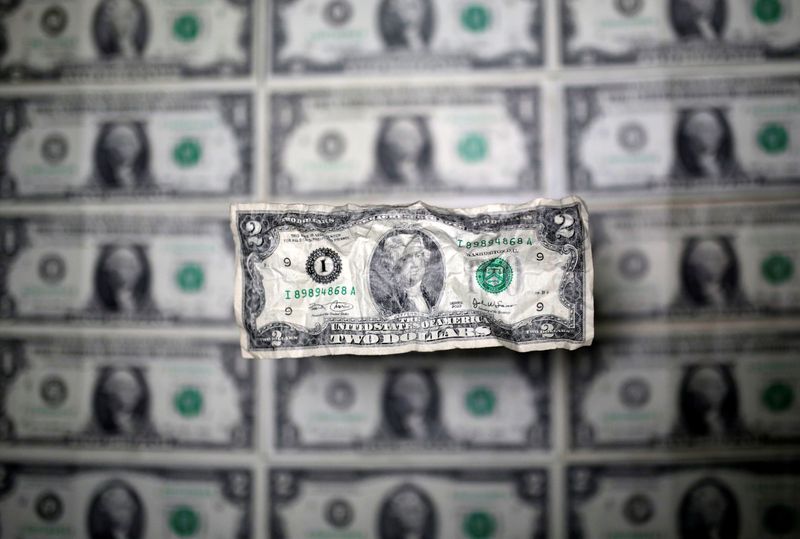

© Reuters. U.S. dollar banknote is seen in this picture illustration taken May 3, 2018. REUTERS/Dado Ruvic/Illustration/file photo
By Ankur Banerjee
SINGAPORE (Reuters) -The dollar nursed steep losses on Thursday and was headed for a yearly decline, while the Swiss franc perched at a nine-year peak and the euro at a five-month high on expectations that 2024 will bring deep rate cuts.
With the year coming to a close, thin liquidity and limited moves are expected until the New Year.
The , which measures the U.S. currency against six rivals, fell to a fresh five-month low of 100.76. The index is on course for a 2.6% decline this year, snapping two straight years of strong gains.
Investor focus remains on the timing of the interest rate cuts from the Federal Reserve, with markets pricing in a 88% chance of a cut in March 2024, according to CME FedWatch tool. Futures imply more than 150 basis points of Fed easing next year.
Some analysts though remain unconvinced the U.S. central bank would be so aggressive.
“We still believe that a March policy change toward easing is much too early and there is quite a bit of potential for a dollar rally if and when such action does not materialize,” Monex USA analysts said in a note.
While the Fed took an unexpectedly dovish stance in its December meeting, opening the door to rate cuts next year, other major central banks, including European Central Bank retained their stance of needing to keep rates higher for longer.
Markets though are still pricing in as much as 165 basis points of rate cuts from the ECB next year.
“The European and UK economies are in a much more precarious state and we believe this will force their respective central banks to cut interest rates both before they are fully ready and before the Fed does so,” said the Monex USA analysts, noting the divergence in the outlooks for the U.S. and European economies.
The euro was last at $1.1117, having touched a fresh five-month peak of $1.11225 earlier in the session. The single currency headed for a yearly gain of 3.7%, its strongest performance since 2020.
The Swiss franc firmed to $0.8395, its strongest level against the dollar since January 2015, when the Swiss National Bank discontinued its policy of having a minimum exchange rate against the euro.
Meanwhile, sterling rose to $1.2816, its highest since Aug. 10. The pound is headed for a 6% gain in the year, its strongest performance since 2017.
Investors expect that the Bank of England will not be able to cut rates as much as the Fed and ECB, given inflation is running higher in the UK. [GBP/]
That has widened the gap between British bond yields and those in the U.S. and Europe, making them look more attractive and boosting the pound.
In Asia, the Japanese yen strengthened 0.52% to 141.09 per dollar, inching closer to a five-month peak of 140.95 it touched earlier this month.
The Asian currency is up 4% against the dollar in December, heading for its second straight month of gains on increased expectations that the Bank of Japan may soon move away from its ultra-loose monetary policy.
The central bank, however, stuck to its policy earlier this month and Governor Kazuo Ueda on Wednesday said he was in no rush to unwind ultra-loose monetary policy as the risk of inflation running well above 2% and accelerating was small.
For the year though yen is down 7% against the dollar.
Rate cut bets have also boosted riskier currencies, with the Australian dollar and the New Zealand dollar perched at fresh five-month peaks. The was last little changed at $0.6844, while the was at $0.6343.
The dollar weakness has also lifted emerging markets currencies. MSCI’s emerging market currency index touched a fresh 20-month high and was on track for its strongest year since 2017 with yearly gains of 5%.


